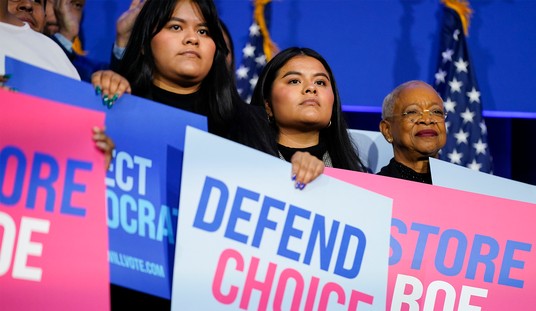When I was a little kid growing up in church, we sang a song — and most of you can probably sing along with it now:
I’ve got the joy, joy, joy, joy, down in my heart (Where?*)
Down in my heart (Where?)
Down in my heart
I’ve got the joy, joy, joy, joy, down in my heart
Down in my heart to staaaaaaaaaaaaaayyyyyy
*The higher-pitched you say the “Where?” the better.
“Joy” has been a word that the Harris-Walz campaign has co-opted in its attempts to contrast the Democrats’ message with that of the GOP. The idea, of course, is that the Democrats offer an exciting vision that looks forward, while Republicans only want to look backward and oppress people.
The images of Kamala Harris cackling like a rabid hyena and Tim Walz lumbering around onstage like a Chris Farley character are supposed to contrast with a defiant, scowling Donald Trump and a serious JD Vance. It’s a level of stereotyping that only Democrats can get away with.
“The Harris campaign has sought to bring various stereotypes of the two parties to the front of the public’s mind,” writes George Hawley at City Journal. “Democrats want to present themselves as the party of the future, optimistic and welcoming change. They seek to portray Republicans, by contrast, as embittered, retrogressive dinosaurs, clinging to unearned privileges. It is not outlandish for people to accept this dichotomy: the trope of the right-wing uncle who ruins family get-togethers with political tirades is now a staple of popular culture.”
It’s a tale as old as time, too. Think about irascible, grumpy Archie Bunker getting his comeuppance from an erudite, smirking liberal. (Granted, often the lefties learned lessons on Norman Lear’s shows, too.) The left loves to paint us conservatives as angry and aggrieved, while leftists are free and fun-loving.
But do the stereotypes bear out? Where’s the joy in Antifa riots? Where’s the joy in transgenders and non-binaries berating others for not using the “correct” pronouns? Where’s the joy in desecrating buildings and works of art in the name of advancing left-wing causes?
Hawley writes that “this description of the parties is not just an oversimplification—it is incorrect. Though the Left likes to characterize conservatism as a reactionary ideology, conservatives themselves consistently claim higher levels of happiness and life satisfaction than progressives.”
Related: The World Needs More Happy Warriors — And I Know Where to Find Them
For about 50 years, a report called the General Social Survey (GSS) has measured the happiness level of respondents. Republicans consistently report slightly higher levels of happiness every year. Hawley points out that Democrats say that they have more emotional issues:
In 2018 and 2021, the survey asked: “In the past seven days, how often have you been bothered by emotional problems such as feeling anxious, depressed or irritable?” The possible responses were “never,” “rarely,” “sometimes,” “often,” and “always.” On this measure, we recently witnessed a dramatic increase in self-reported emotional problems among Democrats, but not among Republicans.
It's not just the GSS reporting more joy among conservatives. A 2008 Pew survey showed that Republicans are better off financially, love their communities more, and have deeper religious faith — and in those findings, gender and ethnicity didn’t play a significant role.
Another measure of conservative happiness comes from family formation. A 2022 poll from YouGov and Deseret News discovered that conservatives’ propensity to live in nuclear families contributed to more joy.
“On the family front, conservative Americans (not politicians, admittedly) have a major advantage,” Brad Wilcox of the Institute for Family Studies wrote of the study, “in large part because they are more likely to embrace the family-first values and virtues that steer them towards wedlock and fulfilling family lives.”
Wilcox also noted:
The survey goes on to find that liberals are about 19 percentage points less likely to be “completely satisfied” with their “mental health” than conservatives. But the problem appears to be especially acute for liberal women, who register the lowest levels of satisfaction with their lives and mental health. Indeed, only 15% of liberal women in the age group surveyed are “completely satisfied” with their lives, compared to 31% of conservative women; likewise, only 15% of liberal women are “completely satisfied” with their mental health, compared to 35% of conservative women.
Other factors such as conservatives believing that they have agency over their lives and less of a willingness to look for inequity in society add to a higher level of happiness. Conservatives also tend to have a greater sense of purpose (outside of politics) than liberals, while Democrats say they tend to feel higher levels of stress when Republicans win elections.
As a Democrat might say, trust the science. If these studies bear anything out, it’s that conservatives tend to have higher levels of happiness, and while happiness and joy are different things, they’re connected.
Hawley concludes:
Regardless of the happiness gap’s underlying cause, its existence undermines the notion that American politics is characterized by confident, optimistic progressives squaring off against dour conservatives. That such stereotypes exist at all suggests poor messaging on the part of Republican politicians and the conservative movement. Angry social media voices are not representative of conservatives overall, and they should not set the tone for the American Right. As Ronald Reagan demonstrated, conservatism is most successful when it presents itself as a positive, cheerful political philosophy. Conservatives do not concede joy in their personal lives; they should not do so in the political arena, either.
Amen! Let’s reflect joy as conservatives from here on out, no matter what happens.










Join the conversation as a VIP Member